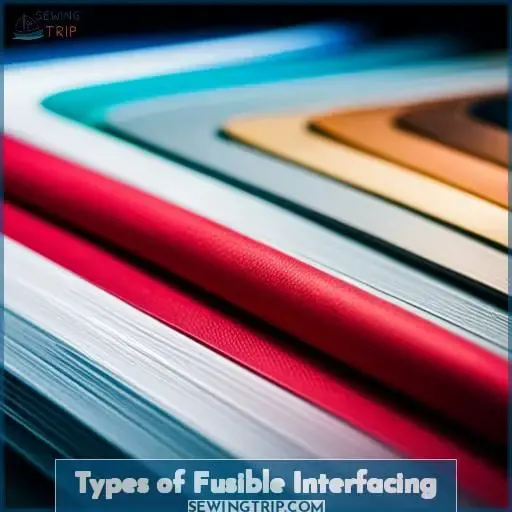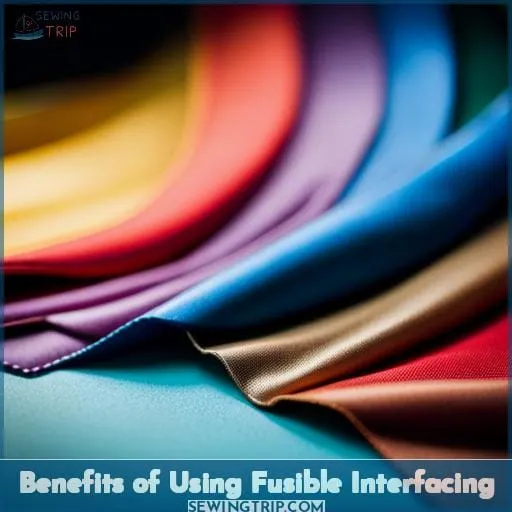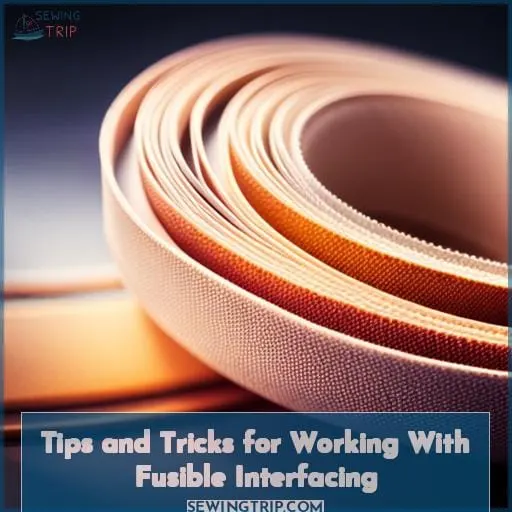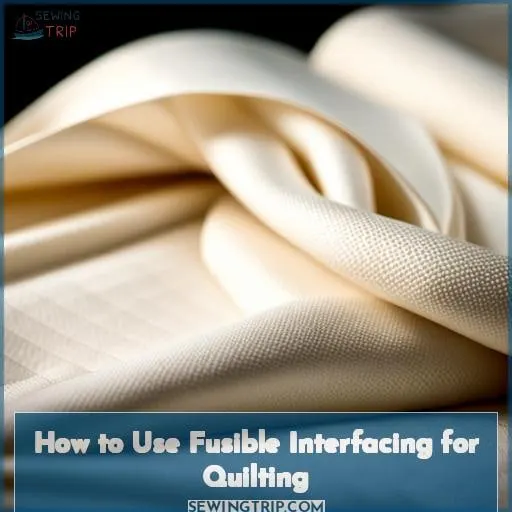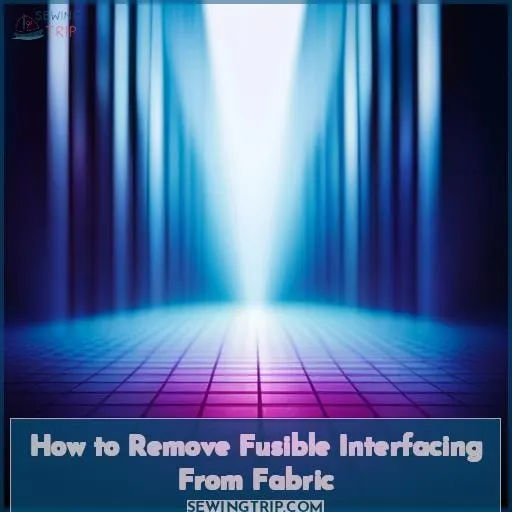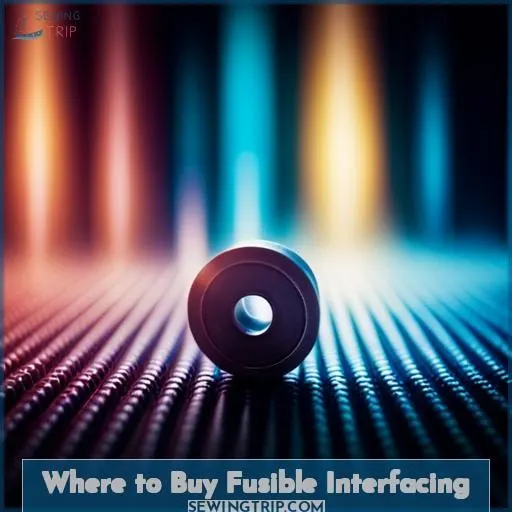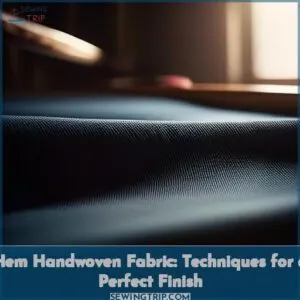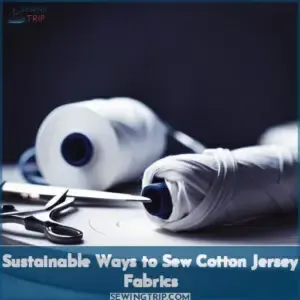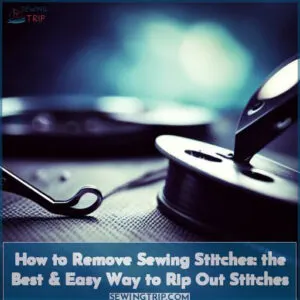This site is supported by our readers. We may earn a commission, at no cost to you, if you purchase through links.
 Don’t let interfacing intimidate you!
Don’t let interfacing intimidate you!
Conquer the art of using fusible interfacing with our comprehensive guide.
We’ll unravel its secrets, empowering you to achieve flawless results every time.
Discover the types of fusible interfacing, their applications, and expert tips for perfect adhesion.
Learn how to overcome common challenges and unleash the full potential of this versatile material.
Take control of your sewing projects and unlock the power of fusible interfacing today!
Table Of Contents
- Key Takeaways
- What is Fusible Interfacing?
- Types of Fusible Interfacing
- How to Apply Fusible Interfacing
- Benefits of Using Fusible Interfacing
- Problems With Fusible Interfacing
- Tips and Tricks for Working With Fusible Interfacing
- How to Use Fusible Interfacing for Quilting
- Popular Brands of Fusible Interfacing
- How to Remove Fusible Interfacing From Fabric
- Where to Buy Fusible Interfacing
- Frequently Asked Questions (FAQs)
- Conclusion
Key Takeaways
- Fusible interfacing adds structure and stability to sewing projects by ironing it onto the wrong side of the fabric.
- There are different types of fusible interfacing, including woven, non-woven, and knit, each with unique properties and uses.
- To apply fusible interfacing, cut it to size, place it on the fabric, and iron it with medium heat and pressure until the bond is secure.
- Fusible interfacing improves fabric stability, enhances garment structure, and simplifies the sewing process.
What is Fusible Interfacing?
When it comes to sewing, you’re probably familiar with fusible interfacing, a fabric that, when introduced to heat, forms a bond with your material. It’s a game-changer for adding structure and stability to your projects, whether you’re creating garments, bags, or quilts.
The weight of the fusible interfacing you choose depends on the desired stiffness of your project. Lightweight interfacing is perfect for delicate fabrics, while heavier interfacing provides more support for heavier fabrics.
Consider the color of the interfacing as well; choose a color that won’t show through your fabric.
The quality of the glue on the interfacing is crucial for a strong bond. Look for interfacing with a strong adhesive that won’t peel off or flake over time. Additionally, the iron temperature settings and the material of your pressing cloth can impact the success of your fusing process.
Types of Fusible Interfacing
Woven fusible interfacing is strong and durable.
Non-woven fusible interfacing is versatile.
Knit fusible interfacing is stretchy and flexible.
Choose the type of fusible interfacing that best suits your fabric and project to achieve the desired results.
Woven
Weaving your way into fusible interfacing’s realm, discover its robustness and durability, making it a pillar of strength for your sewing projects.
Its tightly woven structure lends exceptional stability and support, ideal for structured garments like tailored jackets or crisp shirt collars.
Compared to non-woven interfacing, woven interfacing offers superior tear resistance, ensuring your creations endure the test of time.
Unleash your creativity with woven interfacing’s versatility, seamlessly fusing with woven fabrics like cotton, linen, and wool for a flawless finish.
Non-woven
Next up, non-woven fusible interfacing grants you the freedom to work with various textures, offering versatility for your creative projects.
Explore a table contrasting the properties of woven and non-woven interfacing.
Discover how non-woven’s unique qualities make it ideal for fusing multiple layers, creating structured shapes, and adding body to garments.
Learn about interfacing alternatives, storage tips, and popular fusible interfacing brands to elevate your sewing skills.
Knit
Your knit fusible interfacing is the stretchy and flexible choice for projects that demand elasticity.
It’s a lifesaver for knit fabrics and stretch fabrics, allowing you to maintain their inherent stretchiness while adding stability and structure.
Knit interfacing is also a breeze to work with, making garment construction a smooth and enjoyable process.
How to Apply Fusible Interfacing
Now that you’re familiar with the different types of fusible interfacing, let’s dive into the practical aspect of applying it to your fabric.
-
Prep the Fabric and Interfacing:
- Ensure your fabric and interfacing are cut to the desired size.
- Place the interfacing onto the wrong side of the fabric, ensuring the adhesive side faces down.
-
Set the Iron:
- Refer to the interfacing’s instructions for the recommended iron temperature.
- Generally, a medium heat setting works well for most types.
-
Apply Heat and Pressure:
- Using a dry iron, press down firmly on the interfacing for the specified duration.
- Move the iron in a circular motion, applying even pressure throughout.
-
Test the Bond:
- Once the pressing time is up, lift the iron and allow the fabric to cool for a few minutes.
- Gently peel a corner of the interfacing to check if it’s securely bonded to the fabric. If not, repeat the pressing process.
Benefits of Using Fusible Interfacing
Fusible interfacing can change your sewing game.
It gives your fabric more stability and helps your garments hold their shape better.
It also makes sewing easier by preventing fabrics from shifting around.
It can even help you create crisp pleats and sharp edges.
Improved Fabric Stability
Fusible interfacing’s first benefit is stabilizing your fabric, preventing stretching and sagging, creating a more polished look. Interfacing is available in various stiffness levels, allowing you to achieve the desired stability for your project.
| Fusible Interfacing Type | Fabric Distortion Prevention | Fusible Interfacing Removal | Fusible Interfacing Storage |
|---|---|---|---|
| Woven | Minimal | Difficult | Cool, dry place |
| Non-woven | Moderate | Easy | Cool, dry place |
| Knit | Maximum | Easy | Cool, dry place |
Popular brands include Pellon, Vlieseline, and Freudenberg.
For best results, pre-wash the interfacing, test it on a scrap of fabric, and use a pressing cloth.
Enhanced Garment Structure
By providing structure and strength to the fabric, fusible interfacing can help you achieve a crisper and more professional look in your finished garments.
It’s like having a secret weapon in your sewing arsenal, allowing you to tame unruly fabrics, add sharp pleats, and create collars that stand tall with pride.
With fusible interfacing bonding the fabric from within, your projects will exude stability and structure, transforming them from ordinary to extraordinary.
Simplified Sewing Process
With fusible interfacing holding your fabric steady, you’ll sew seams and fasten buttons in a breeze.
Its stabilizing effect tames unruly fabrics, making them cooperative partners in your creative journey.
Choose the right interfacing, master fusing techniques, and discover the ideal iron temperature and pressing methods for your fabric.
Once you’ve got the hang of it, you’ll wonder how you ever sewed without this game-changing tool.
Problems With Fusible Interfacing
Sometimes fusible interfacing doesn’t stick, even when you press it according to the instructions.
You might’ve ironed the wrong side of the interfacing.
Some fabrics don’t work well with fusible interfacing.
If you’re not careful, you could end up with distorted or wrinkled fabric.
Fusible Interfacing Not Sticking
If you run into trouble with your fusible interfacing not adhering properly, let’s troubleshoot the issue together.
First, ensure the glue side of the interfacing is facing up.
Second, avoid using too much heat or applying too much pressure, as this can cause the glue to melt and stick to the iron instead of the fabric.
Third, check if you’re using the right type of fabric, as some fabrics, like synthetics, may not bond well with fusible interfacing.
The Wrong Side of the Interfacing Was Ironed
Turn it over! You’ve ironed the wrong side of the interfacing. That’s why the glue didn’t stick to the fabric.
Now you’ll likely have related discoloration, glue seeping through the fabric, or puckering from excess heat.
Choose the appropriate heat setting to minimize fabric damage.
Test a scrap of fabric first.
This simple step can save you a lot of time and frustration.
Fusible Interfacing Does Not Work With Some Fabrics
When using fusible interfacing, be aware that it might not work well with certain fabrics, particularly delicate ones or those prone to melting when exposed to heat.
In these cases, explore fusible interfacing alternatives like sew-in interfacing or use a lightweight interfacing specifically designed for delicate fabrics.
Different types of interfacing are available for stretch fabrics, heavy fabrics, and various textures.
Choose the interfacing that best suits your fabric and project to ensure successful results.
Fabric May Be Distorted or Wrinkled
Watch out for fabric distortion or wrinkling caused by improper application of fusible interfacing.
Avoid iron-on interfacing on delicate fabrics that cannot withstand heat.
When fusing interfacing to bumpy fabric texture, place it between two layers of fabric to prevent puckering.
If wrinkled fabric occurs, remove the interfacing layer and reapply it, ensuring the iron is at the correct temperature and the fabric is smooth.
Tips and Tricks for Working With Fusible Interfacing
To ensure a flawless fusing experience:
- Pre-wash your fusible interfacing to prevent shrinkage.
- Always test it on a scrap of fabric first.
Save time by fusing large pieces of interfacing to fabric before cutting out your pattern pieces.
Pre-Wash Fusible Interfacing
Pre-washing fusible interfacing removes chemicals and coatings that hinder adhesion to fabric.
This simple step ensures a strong bond between the interfacing and fabric, leading to better results in your projects.
Enhances Adhesion:
Pre-washing removes any residue that might interfere with the adhesive’s ability to bond with the fabric, resulting in a stronger hold.
Prevents Discoloration:
Some interfacings contain dyes or chemicals that can bleed into the fabric during ironing. Pre-washing removes these substances, preventing discoloration.
Extends Lifespan:
Pre-washing helps preserve the integrity of the interfacing, extending its lifespan and ensuring it remains effective for longer.
Always Test First
Before you commit to fusing the interfacing to your precious main fabric, test it on a scrap of the same fabric.
This mini experiment ensures the adhesive strength is up to par, preventing glue residue from marring your project.
Plus, you’ll discover if the fabric piece shrinks, warps, or puckers, allowing you to adjust your interfacing care instructions and storage tips accordingly.
Testing first is a small step that can save you time, money, and heartache.
Save Time by Fusing Large Pieces of Interfacing
Fuse large pieces of interfacing in one go to save time when working on extensive projects.
Bulk fusing is a smart strategy for large-scale interfacing needs.
Cut a large piece of interfacing, place it on multiple fabric pieces simultaneously, and fuse them all at once.
This technique boosts your fusing efficiency, allowing you to breeze through interfacing tasks in no time.
Sewing Through Fusible Interfacing
Moving on to sewing through fusible interfacing, you’ll want to use a sharp needle and slow, even stitches to avoid snagging or tearing the fabric.
Reduce Machine Pressure:
Lowering your sewing machine‘s pressure helps prevent puckering or damage to the fabric.
Avoid Fraying:
Use a zigzag stitch or serger to keep the edges of the interfacing from fraying.
Fuse Stretchy Fabrics Carefully:
When working with stretchy fabrics, use a lightweight interfacing and fuse it gently to avoid distorting the fabric.
Seam Allowances:
Trim seam allowances close to the stitching to reduce bulk and ensure a smooth finish.
How to Use Fusible Interfacing for Quilting
Quilters, let’s explore how fusible interfacing can elevate your quilting projects by providing stability and structure to your fabric pieces.
- Precise piecing: Fusible interfacing helps maintain fabric shape, ensuring accurate piecing and sharp seam lines, minimizing distortion and stretching.
- Crisp, defined edges: Interfacing adds body to quilt blocks, resulting in crisp, defined edges that enhance the overall visual appeal of your quilt.
- Stabilize appliqué: Use lightweight fusible interfacing to stabilize appliqué pieces, preventing fraying and ensuring they adhere securely to the quilt top.
- Create structured quilt blocks: Heavyweight fusible interfacing adds rigidity to quilt blocks, making them ideal for creating dimensional and sculptural effects.
- Reinforce quilt layers: Interfacing can reinforce quilt layers, preventing stretching and sagging, resulting in a quilt that maintains its shape and integrity over time.
Popular Brands of Fusible Interfacing
Now that you’ve explored fusible interfacing for quilting, let’s delve into several popular brands that offer high-quality options for your projects.
From Vliseline’s reliable performance to Pellon’s diverse range, each brand brings unique strengths to the table.
Vliseline, a top choice among quilters, boasts a reputation for consistent quality and ease of use. Its interfacings bond seamlessly with various fabrics, providing excellent stability and structure.
Pellon, another renowned brand, offers an extensive selection of interfacings, catering to a wide range of quilting needs. Its lightweight options provide subtle support, while its heavier interfacings lend unwavering firmness.
When selecting a brand, consider factors like quality, availability, and personal preferences.
Read fusible interfacing reviews and compare brands to make an informed decision.
Experimenting with different brands will help you discover the ones that best suit your quilting style and project requirements.
How to Remove Fusible Interfacing From Fabric
Having mastered the art of applying fusible interfacing, let’s explore the techniques for removing it from fabric when necessary.
If you find yourself in a situation where you need to remove fusible interfacing, there are a few methods you can try:
-
Freeze and Peel:
- Place the fabric with the interfacing in the freezer for a few hours.
- The cold will make the interfacing brittle, and you can then peel it off.
-
Use a Solvent:
- Apply a solvent like acetone or nail polish remover to the interfacing.
- Let it sit for a few minutes, then scrape it off with a dull knife or credit card.
-
Heat and Peel:
- Place a cloth over the interfacing and iron it on a low setting.
- The heat will soften the adhesive, and you can then peel off the interfacing.
-
Use a Seam Ripper:
- If all else fails, you can use a seam ripper to carefully cut away the interfacing.
- Be careful not to damage the fabric.
Where to Buy Fusible Interfacing
You can find fusible interfacing at your local fabric store or online retailers like Amazon.
Fabric stores often carry a wide selection of fusible interfacing brands and weights, allowing you to choose the perfect one for your project.
Online retailers offer a vast selection of fusible interfacing options, enabling you to compare prices and read customer reviews before making a purchase.
Craft stores also stock fusible interfacing, along with other sewing supplies and notions.
Explore different brands and compare prices to find the best deal on fusible interfacing that suits your needs and budget.
Frequently Asked Questions (FAQs)
What are the different ways to identify the fusible side of interfacing?
To spot the fusible side of interfacing, look for the dotty or textured side.
That’s the one you want facing down onto the wrong side of your fabric.
Some brands use a shiny glue film instead, so that side goes down.
How can I tell if I am using the correct weight of interfacing for my fabric?
To ensure your fabric maintains its shape and structure, match the weight of the interfacing to the weight of the fabric:
Heavier interfacing for stiffer fabrics.
Lighter interfacing for delicate fabrics.
What are some common mistakes people make when using fusible interfacing?
Don’t let your interfacing mishaps turn your sewing project into a tangled mess!
Avoid the pitfalls of:
- Improper application
- Mismatched weights
- Scorched fabrics
Master the art of fusible interfacing and conquer your sewing endeavors with finesse.
How do I prevent fusible interfacing from bubbling or puckering when I iron it on?
To prevent bubbling or puckering:
- Ensure your iron is at the correct temperature.
- Move it steadily over the fusible interfacing, applying even pressure.
What are some creative ways to use fusible interfacing in sewing projects?
Imagine a limp fabric transformed into a crisp, structured masterpiece.
Fusible interfacing is your magic wand, adding body, stability, and a dash of creativity to your sewing projects.
Unleash your imagination and explore endless possibilities.
Conclusion
With fusible interfacing now in your creative arsenal, you’re a sewing superhero, ready to conquer any project with confidence.
Embrace its versatility and unlock the secrets to flawless results.
Your sewing journey will be transformed, opening doors to a world of impeccable finishes and professional-looking garments.

